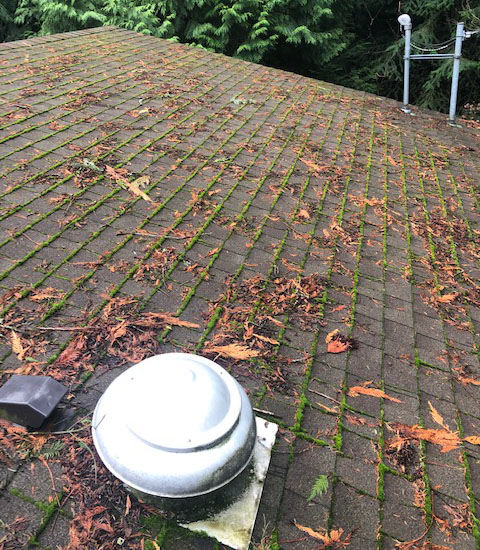Moss growth on roofs has become a common phenomenon, but it’s not always clear why. Some people believe that moss on roofs is a sign of neglect or poor maintenance, while others assume that it’s simply a result of damp conditions.
In reality, the reasons why moss collects on roofs are much more complex than you might expect. In this article, we’ll explore the fascinating science behind moss growth on roofs and explain why it happens in the first place.
What is Moss?
Moss is often regarded as a general term for non-vascular herbaceous plants that grow rapidly in damp conditions. Therefore, in most cases, mosses are a mixture of 3 different organisms:
- Moss: Moss is a non-vascular flowerless plant that grows in dense areas. Hence, they usually develop from water-based plants. Moss needs plenty of water to grow, but they won’t be able to grow if they get completely immersed in water. A general attribute common to mosses is that they are generally springy to the touch.
- Algae: Alga is a single-cell plant that grows in clusters inside water. It is a non-vascular plant so it has no root, stem, or leaves.
- Lichen: Lichen is a combination of algae and fungi. Technically, Lichen is not a plant. Instead, it is a fungus because it shares most of its characteristics with fungi. Meanwhile, it gets the rest of its characteristics from the green or blue-green algae.
Generally, mosses are one of the fastest-growing plants. They can quickly grow and multiply across your roof within a few days.
Why Does Moss Grow on Roofs?
There are two major factors that promote the growth of moss, algae, and lichen on your roof.
One of these factors is the presence of moisture and organic debris. Cool and damp environments are very hospitable for the growth of moss. As long as there is plenty of moisture trapped in an area, moss can easily make that area its next habitat. Therefore, the more water and debris in an area, the bigger the chances of seeing moss growth.
It gets worse if your roof is well-shaded because excess shading roof prevents sunlight from getting to the roof. If enough sunlight isn’t getting to your roof, the evaporation of moisture from your roof slows down, thereby creating suitable conditions for the moss to grow.
Negative Effects of Moss on Roofs
Moss itself may not be very harmful. It doesn’t release toxic fumes or spores, and it doesn’t secret any poisonous substance.
The biggest negative effect moss can have on roofs lies in its ability to retain moisture. Generally, when weather elements like rainwater or snow residue gather on the roof, they mostly dry out before they stay long enough to cause damage.
However, moisture can easily be retained on the roof with the presence of moss. Moreover, moss is naturally a wet kind of plant. Their naturally wet nature, plus the amount of moisture they usually retain, can cause significant harm to your roof.
The presence of excess moisture on your roof can cause decomposition and rot. On another note, the excessive moisture moss soaks up make them quite heavy. In fact, you’d be surprised by how much a mat of moss can weigh. This excess weight is not something your roof was designed to handle.
Eventually, the additional weight moss adds can bring about some form of disaster sooner or later.
Additionally, as moss grows on your roof, they occupy spaces between your tiles and shingles. Eventually, they drive out the tile and shingles and then occupy those spaces.
On top of that, moss makes a suitable host for all kinds of pests, bugs, and insects. And as you already know, pests and insects in any structure within your home is usually not a good thing.
Preventing and Removing Moss on Roofs
Here are some things you can do to prevent and remove moss from your roofs.
-
Prune your trees
When you prune your trees and keep your roof leave-free, it goes a long way in helping you to prevent the presence of organic fertilizers on your roof. Ensure to prune nearby trees and remove twigs, leaves, and branches from your roof.
Trimming your trees will also help ensure that your roof gets enough sunlight to speed up moisture evaporation from the roof.
-
Clean your gutters
Allowing your gutters to become clogged for long periods means you are breeding a healthy ground for moss growth. With clogged gutters, you will probably have excess debris and the overflow of water residue on your roof.
In this process, you will indirectly be facilitating the presence of water and plants rich in the nutrients moss needs for adequate growth. So, to avoid situations like this, you should clean your gutters regularly.
-
Hire professionals to help you deal with it
We recommend hiring professionals to help you carry out routine maintenance checks and preventive care. Roofing professionals like Shoreline Roofing can help you take the proper precautions and preventive measures your roof needs.
Conclusion
Moss growth on roofs is a natural phenomenon that can cause significant damage to your home if left unchecked. Therefore, you must take proper preventative measures to keep them at bay.
At Shoreline Roofing, we offer a range of roofing services, including moss removal, to help keep your roof in top condition. Contact us today to schedule a consultation and learn more about how we can help protect your home from the effects of moss.

